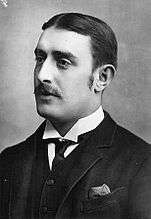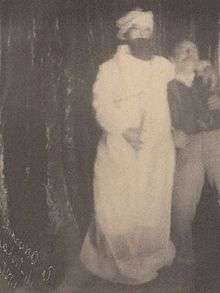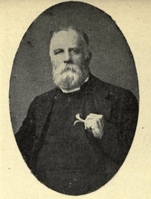William Eglinton


William Eglinton also known as William Eglington (1857–1933) was a British spiritualist medium who was exposed as a fraud.[1][2][3][4]
Biography

Eglinton was born in Islington, London. He claimed to materialize spirits in his séances.[5] It was discovered that the materializations were fakes.[6]
In 1876, Eglinton was exposed as a fraud when the psychical researcher Thomas Colley seized the "spirit" materialization known as "Abdullah" and cut off a portion of its cloak. It was discovered that the cut piece matched a cloth found in Eglinton's suitcase.[7] Colley also pulled the beard off the materialization and it was revealed to be a fake, the same as another one found in the suitcase of Eglinton.[8]
In 1882, the American magician Harry Kellar was baffled by an alleged levitation of Eglinton.[9] Massimo Polidoro has written that Kellar did not "impose any form of control" and "couldn't see anything" in the dark séance room but still convinced himself Eglinton levitated.[3] According to the magician Harry Houdini although Kellar was originally baffled by Eglinton's levitation when he gave the subject fuller consideration he was able to reproduce the same phenomena by trickery.[10] Houdini wrote "it was not strange that Kellar did not detect Eglinton's method instantly nor is it strange that he acknowledged that he was baffled. No magician is immune from being deceived and it is no way beneath a magician's dignity or demeaning to professional reputation to openly admit that he cannot always account for what he thinks he sees."[11] Magic historian Barry Wiley wrote that Eglinton was exposed as a fraud several years later.[9]
In 1886 the spiritualist John Stephen Farmer wrote a biography of Eglinton.[12]
Eglinton performed slate writing mediumship and his leading critics were the psychical researchers Eleanor Sidgwick and Richard Hodgson.[13] In 1886 and 1887 a series of publications by S. J. Davey, Hodgson and Sidgwick in the Journal for the Society for Psychical Research exposed the slate writing tricks of Eglinton.[14] Due to the critical papers, Stainton Moses and other prominent spiritualist members resigned from the SPR.[15][16]
Hereward Carrington has written that Eglinton was involved with Madame Blavatsky in producing fraudulent Mahatma letters.[1] Frank Podmore wrote "Eglinton had on at least two occasions been detected in fraudulently simulating occult phenomena... Moreover, several observers claimed to have seen Eglinton actually writing on the slates with his own hands." Professor Carvill Lewis during a séance with Eglinton heard him write on the slates and observed writing movements.[17] Lewis had also discovered that Eglinton had looked up answers to questions in a dictionary.[18]
References
- 1 2 Hereward Carrington. (1907). The Physical Phenomena of Spiritualism. Herbert B. Turner & Co. pp. 84–90
- ↑ Simeon Edmunds. (1966). Spiritualism: A Critical Survey. Aquarian Press. p. 105. ISBN 978-0850300130 "1876 also saw the first of several exposures of another physical medium, William Eglington, in whose trunk a false beard and a quantity of muslin were found by Archdeacon Colley. He was exposed again in 1880, after which he turned to slate-writing. In this he was exposed by Richard Hodgson and S. J. Davey of the SPR in 1885. Davey a clever conjuror, was able to duplicate all Eglington's phenomena so perfectly that some spiritualists, notably Alfred Russel Wallace, insisted that he too was really a genuine medium."
- 1 2 Massimo Polidoro. (2001). Final Séance: The Strange Friendship Between Houdini and Conan Doyle. Prometheus Books. p. 51. ISBN 978-1573928960
- ↑ Paul Kurtz. (1985). A Skeptic's Handbook of Parapsychology. Prometheus Books. p. 277. ISBN 978-0879753009 "The most important bogus medium in history was William Eglinton, who began his corrupt activities in adolescence. Important because the ultimate effect of his slate-writing trickery was to revolutionize psychical investigations."
- ↑ Raymond Buckland. (2005). The Spirit Book: The Encyclopedia of Clairvoyance, Channeling, and Spirit Communication. Visible Ink Press. p. 125. ISBN 978-1578592135
- ↑ Montague Summers. (2010). Physical Phenomena of Mysticism. Kessinger Publishing. p. 114. ISBN 978-1161363654
- ↑ Joseph McCabe. (1920). Is Spiritualism based on Fraud?: The Evidence Given by Sir A.C. Doyle and Others Drastically Examined. London: Watts & Co. p. 115. "The English medium Eglinton adopted and improved his methods, and he was one of the bright stars of the Spiritualist world for twenty years. He was detected in fraud as early as 1876. At that time he gave materialization-stances, at which the ghostly form of "Abdullah" appeared. Archdeacon Colley found the beard and draperies of Abdullah in his trunk."
- ↑ Roy Stemman. (1976). The Supernatural. Danbury Press. p. 62
- 1 2 Barry Wiley. (2012). The Thought Reader Craze: Victorian Science at the Enchanted Boundary. McFarland. p. 35. ISBN 978-0786464708
- ↑ Harry Houdini. (1922). Spirit Compacts Unfilled. The Sun. 30 October.
- ↑ Harry Houdini. (2011 edition). A Magician Among the Spirits. Cambridge University Press. p. 263. ISBN 978-1108027489
- ↑ John Stephen Farmer. (1886). Twixt Two Worlds: A Narrative of the Life and Work of William Eglinton. The Psychological Press, London.
- ↑ Ronald Pearsall. (1972). The Table-Rappers. Book Club Associates. pp. 109–110. "The leading exponent of slate writing was William Eglinton; his leading critics were Mrs Sidgwick and Richard Hodgson. Hodgson had created a stir by his expose of theosophy, and neither he nor Mrs Sidgwick was impressed by Eglinton."
- ↑ Janet Oppenheim. (1988). The Other World: Spiritualism and Psychical Research in England, 1850–1914. Cambridge University Press. pp. 139–140. ISBN 978-0521347679
- ↑ Roger Luckhurst. (2002). The Invention of Telepathy, 1870–1901. Oxford University Press. p. 57. ISBN 978-0199249626
- ↑ Rhodri Hayward. (2014). Resisting History: Religious Transcendence and the Invention of the Unconscious. Manchester University Press. p. 47. ISBN 978-0719095375
- ↑ Frank Podmore. (2011 edition). Modern Spiritualism: A History and a Criticism. Volume 2. Cambridge University Press. p. 206. ISBN 978-1108072588
- ↑ Georgina Byrne. (2010). Modern Spiritualism and the Church of England, 1850–1939. Boydell Press. p. 52. ISBN 978-1843835899
Further reading
- Edward Clodd. (1917). The Question: A Brief History and Examination of Modern Spiritualism. Grant Richards, London. pp. 50–106
- Carvill Lewis. (1887). The Alleged Physical Phenomena of Spiritualism: An Account of Two Séances. Journal of the Society for Psychical Research. Part XI.
- Walter Mann. (1919). The Follies and Frauds of Spiritualism. Rationalist Association. London: Watts & Co. pp. 66–69
- Eleanor Sidgwick. (1886). Mr. Eglinton. Journal of the Society for Psychical Research 2: 282–334.